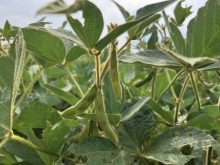Soybeans have a reputation for being able to overcome stresses while yielding a decent crop.
The 2023 growing season tested this reputation, from late planting in parts of Ontario, a short dry spell immediately after that, and a wetter-than normal summer. Growers across much of the province expected to see yield losses compounded by a late harvest.
Yet a pair of advisors say yields and quality are surprising – in a good way – so far.
Read Also

Claas brings 1000 Series SP forage harvesters to Canada
In mid-August, Claas unveiled its new line of Jaguar forage harvesters at an event in Visalia, California, deep in the heart of that state’s dairy region.
White mould has been a near-perennial issue for eastern Ontario and while some were hit harder in 2023 than in other years, growers have learned to manage it, says Paul Hermans.
“It’s that proverbial Tale of Two Cities,” says Hermans, area agronomist for Corteva Agriscience, based near Richmond. “For areas that are heavy hit (with white mould), we’re getting 25 to 40 bushels per acre, but where we’re not, we’re getting 60 to 70. A few guys are getting 80 and even a couple who’ve hit 90 to 98.”
It’s been rough for producers with low yields, but Hermans says one customer told him that, the last time he had a severe white mould infection in 2013, he yielded seven to 15 bushels.
It’s a tip-of-the-cap to breeders for developing hardier, more resilient varieties, but it’s also recognition of growers’ management of white mould or soybean cyst nematode.
“Yes, 25 to 40 is terrible but compared to what it was 10 years ago, we’ve come quite a long way in terms of improving yields with all of those other factors,” says Hermans.
He saw more sudden death syndrome, brown stem rot and cyst nematode. Root rots were also more of an issue, including fusarium and phytopthora. Hermans acknowledges the time required to develop varieties with better tolerance or resistance to various diseases or weeds, but growers are adapting through agronomics and management.
“We have more people using desiccants on their beans this year, to try to speed things up to get their winter wheat in. More growers are asking about that because winter wheat acres are increasing in eastern Ontario.”
According to Colin Richardson, many growers in the south saw the same conditions as Hermans did in the east. Those hit by white mould saw lower yields but those who didn’t had good seed quality, moisture levels and yields.
“Overall, we’re impressed with the yields and quality we’re seeing with early harvested fields,” says Richardson, export manager for Snobelen Farms near Lucknow.
“After a dry planting season and some emergence issues, the soybeans managed to steadily progress. Despite huge rainfall amounts in some areas – three to five times more than average in July and August – we managed to get through with very little pressure from insects or disease.”
Roughly 10 per cent of the soybean crop is harvested in his area, and much of it is IP (identity persevered) soybeans. Although pressure from bean leaf beetle, aphids and stink bugs rose late in the summer, numbers never reached economic threshold levels that required action.
Given excessive rainfall in July and August, Richardson said he is surprised at the limited yield loss. And in spite of an expected white mould outbreak late in the summer, he didn’t see as much as expected.
“Perhaps it was cool enough with low humidity to not make a widespread problem. Unfortunately, since moisture was not a limiting factor, it was hard to see any physiological plant effect of SCN in the field.”
Richardson notes that, so far, seed size looks smaller than the 2022 crop.
“We’re definitely lucky our growers have taken such a holistic and integrated approach to issues like SCN,” says Richardson. “We have a lot of tools in the belt to utilize, including resistant varieties, crop management techniques, as well as certain inputs.”















